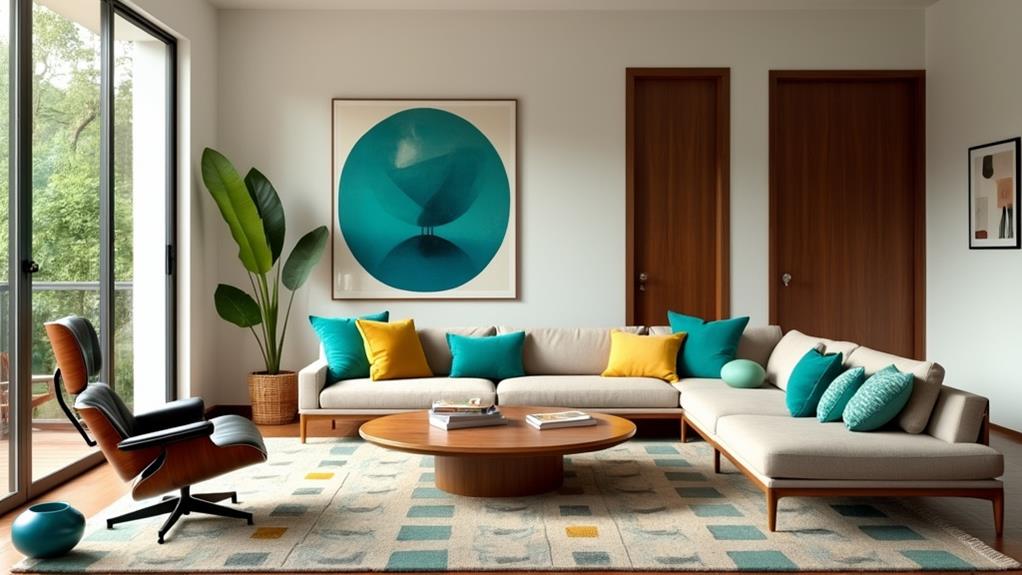To master Mid-Century Modern furniture design, immerse yourself in its foundational elements of simplicity and functionality. This style emphasizes clean lines and organic shapes, making it crucial to choose iconic pieces like the Eames Lounge Chair. Understanding balance in form and function is essential, as these designs blend beauty with practicality through materials like teak and leather. Selecting neutral bases with bold accents enhances visual harmony, while mixing textures like wood and metal adds depth. Verify authenticity through hallmark traits and craftsmanship to guarantee quality and investment value. As you apply these principles, more insights into this enchanting style will unfold.
Table of Contents
ToggleUnderstanding Mid-Century Modern Style
Understanding Mid-Century Modern style involves recognizing the unique blend of simplicity, functionality, and aesthetic appeal that defines this enduring design movement.
You'll find that it emerged in the mid-20th century, characterized by clean lines and organic shapes. This style captivates because it emphasizes a balance between form and function, ensuring that each piece isn't only beautiful but also practical.
Key features include the use of natural materials like wood and leather, which create a warm, inviting atmosphere. The focus remains on achieving a cohesive look, where visual harmony is paramount.
Choosing Iconic Furniture Pieces
As you embrace the timeless allure of Mid-Century Modern style, selecting iconic furniture pieces becomes a key step in bringing this aesthetic to life.
Start with renowned designs like the Eames Lounge Chair or the Saarinen Tulip Table, which exemplify the era's emphasis on clean lines and functionality. These pieces serve as focal points, setting the tone for your space.
Consider the scale and proportion of each item to guarantee they don't overwhelm your room. Mix and match different designs to create visual interest, allowing your personal style to guide your choices.
Opt for pieces with minimalist embellishments, focusing on organic shapes and sleek, straight lines. This approach helps you achieve a balanced and cohesive interior, true to Mid-Century Modern principles.
Ensuring Authenticity and Quality
To truly honor the Mid-Century Modern aesthetic, it's essential to guarantee the authenticity and quality of your furniture pieces.
Start by researching the designer's hallmark traits and construction techniques, ensuring that each piece aligns with historical accuracy. Look for original labels or signatures that authenticate the furniture's origin. Quality reproductions are an alternative, but verify they adhere to the original design's integrity.
Examine the materials used; genuine Mid-Century Modern pieces often feature teak, walnut, or rosewood. Inspect joints and craftsmanship, as these details reveal the furniture's durability.
Authentic pieces exhibit precision and attention to detail, reflecting the period's design ethos. By ensuring authenticity, you preserve the iconic style's essence, enhancing both aesthetic appeal and investment value.
Colors and Materials in Design
After ensuring authenticity and quality in your Mid-Century Modern furniture, it's time to explore how colors and materials can elevate your design.
Start with a neutral base like white, beige, or gray to emphasize vibrant accents. Earthy tones and bold primary colors add depth and interest.
Natural materials such as teak, walnut, leather, and metal create a connection to nature, promoting a serene environment. Incorporate various textures, from smooth wood finishes to soft textiles, enhancing visual appeal.
Employ colorful accessories like throw pillows and ceramics for dynamic bursts of color. Mixing materials, such as pairing metal with wood, further enhances aesthetic appeal.
These thoughtful choices will help you craft a space that feels both timeless and visually engaging.
Achieving Visual Harmony
Creating visual harmony in your space means pulling together various design elements to form a cohesive and balanced look.
Start by establishing a consistent color palette that complements your existing decor. Use neutral tones as a base, allowing statement pieces to shine without overwhelming the room.
Arrange furniture to encourage smooth flow and visual balance, ensuring each piece complements the others in scale and proportion. Incorporate area rugs to define spaces and create distinct zones within open floor plans.
Select artwork that echoes the style and colors of your furniture, reinforcing unity. Regularly review your design, making adjustments as needed to maintain harmony.
Mixing Textures and Accents
When you're looking to enhance your mid-century modern space, mixing textures and accents is key to adding depth and interest.
Start by combining different materials like wood, metal, and leather. Wood's warmth contrasts beautifully with metal's sleekness, creating a balanced aesthetic. Soft textiles, such as wool or linen, can add a cozy element, while leather introduces sophistication.
Accents, like colorful throw pillows or ceramics, inject personality and vibrancy. Consider using patterns sparingly; geometric designs complement mid-century modern's clean lines.
Use area rugs to define spaces and introduce additional texture. Lighting fixtures in brass or chrome can serve as both functional and decorative elements.
Ultimately, blending these textures and accents guarantees a dynamic and inviting environment.
Caring for Your Furniture
Regular care is essential to maintaining the beauty and longevity of your mid-century modern furniture. Start by dusting surfaces regularly to prevent buildup, which can damage finishes over time.
Use coasters and placemats to shield delicate materials from spills and scratches. Avoid placing furniture in direct sunlight, as this can fade fabrics and diminish the luster of wood finishes.
Periodic polishing of wooden pieces is advisable, using a gentle, non-abrasive polish that enhances the natural grain. When dealing with vintage or valuable pieces, consider professional restoration to uphold their integrity and value.
Such attention to detail guarantees your furniture remains a timeless centerpiece, preserving its aesthetic appeal while extending its functional life. Consistent upkeep will keep your collection looking pristine.


